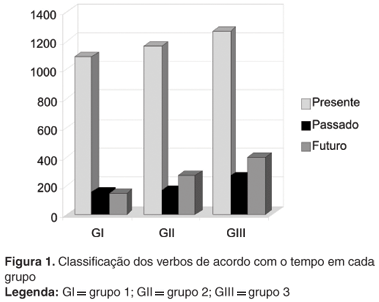PURPOSE: This study sought to quantitatively analyze the use of tense (present, past or future), mood (indicative, subjunctive or imperative), number (singular or plural) and person (first, second or third) of the verbs enunciated in spontaneous speech by Brazilian Portuguese-speaking preschoolers from the city of São Paulo with normal language development. METHODS: Speech samples from 60 preschoolers divided into three groups, paired by gender and age: GI (between 2:0 and 2:11 years), GII (between 3:0 and 3:11 years) and GIII (between 4:0 and 4:11 years). RESULTS: Within-groups analysis showed prevalence of the use of indicative mood, present tense, singular and third person. Between-groups analysis indicated that the use of the indicative mood increased with age, while imperative decreased and subjunctive almost did not occur in this sample. The present tense did not show differences between groups, while past and future increased. Regarding number, the use of singular prevailed, but both singular and plural increased with age. Finally, the use of third person was prevalent, and the use of second person decreased, while first person increased from GI to GIII. CONCLUSION: The results showed that the preschoolers studied perfected the use of verbal morphology during their development, showing a gradual evolution on the domain of the aspects analyzed. No statistically significant differences were found in gender comparisons.
Language development; Child language; Vocabulary; Child, preschool




